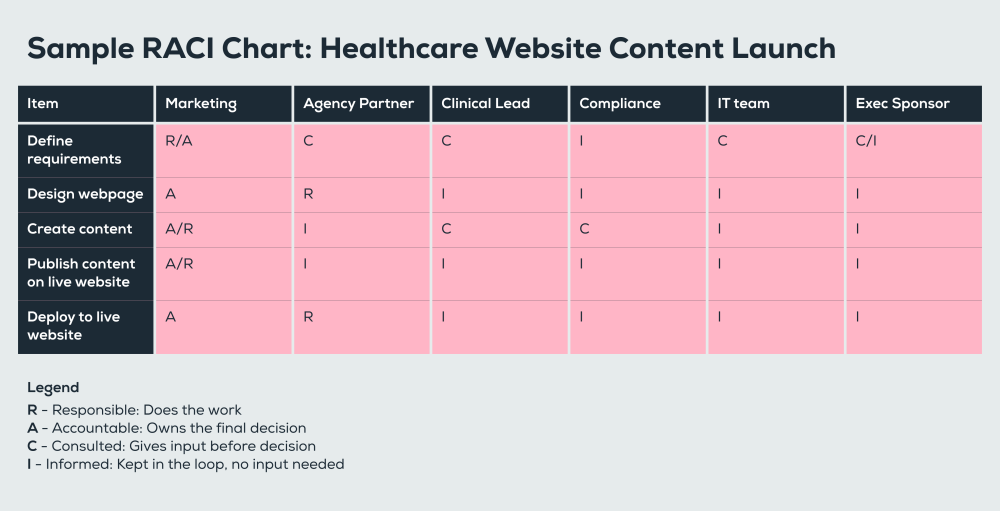Who Really Owns Your Hospital’s Website?
Struggling with hospital website management? Learn how marketing-led strategy and RACI improve speed, clarity, and patient outcomes.

Why Marketing Must Take the Lead
If you lead marketing at a hospital or health system, you’ve likely spent more time managing opinions than executing strategy. Compliance, clinical, legal, finance; everyone has input. And suddenly, your website feels more like a political compromise than a tool for patients.
The issue isn’t collaboration. It’s ownership. When marketing doesn’t lead, the patient experience suffers, and so do your results.
Confusing navigation, jargon-heavy content, and bloated workflows directly impact appointment volumes, patient trust, and credibility.
Marketing is the only team built to see across departments and speak for the patient. But if you’re stuck chasing consensus, you can’t do that job.
This guide is about reclaiming your role. Not by excluding stakeholders, but by leading with clarity, structure, and purpose. And your digital agency should help reinforce your authority, not compete with it.
The Hidden Cost of Healthcare Website Bottlenecks
It starts with good intentions: you invite feedback, align stakeholders, and try to build consensus. But that consensus comes at a cost:
- Endless revisions
- Delayed launches
- Content that tries to say everything and ends up saying nothing
Suddenly, language is technically correct but emotionally flat. The website navigation menu mirrors internal structures rather than patient needs. Calls to action are vague or missing all together.
We even had one case where the CEO wanted to change the search algorithm so that his profile page came up before other results!
Meanwhile, your competitors are publishing content that’s simpler, clearer, and more patient-focused. They’re earning trust and appointments, while you’re still revising copy.
Healthcare marketing is most effective when it’s decisive: the right message, for the right person, at the right time. Internal agendas turn your content into a battleground. The precision patients need disappears. What you gain in consensus, you lose in clarity and results.
You Know the Patient Journey Better Than Anyone Else. Act Like It.
As a healthcare marketer, you know more about the patient journey than any other department. You track how people search. You test headlines. You analyze conversions. You understand what makes patients take action.
Your job is to make care findable, understandable, and accessible.
Just as clinicians are experts in care delivery, you’re the expert in digital communication. When it comes to website content, navigation, and experience design, your voice should lead.
Marketing isn’t overstepping when it claims ownership—it’s doing its job.
How to Use RACI to Govern Hospital Website Projects
You don’t need to exclude stakeholders to lead. You need a clear governance model. And the most effective way to create one is with a simple tool: RACI.
Here’s how to put it into action:
- Phase 1: Initial Alignment
- Kick off: set a one stakeholder alignment meeting before design or content begins. Use it to define success metrics, audiences, decision rights, key requirements and feedback expectations.
- Define the RACI:
- Responsible: Who executes the work
- Accountable: Who makes the final call (hint: Marketing)
- Consulted: A small group (max 3) for expert input
- Informed: Stakeholders who receive updates, not edit access
- Phase 2: Ongoing Communication
- Set default timelines when communicating with stakeholders: For example, “This page goes live Friday, unless we receive edits by Wednesday.”
- Filter feedback based on the RACI: For example, while the operations director might have identified an alert system feature as a requirement for the website during the initial alignment, he shouldn’t be responsible for approving its design.
This kind of structure helps you avoid delays, manage stakeholder overreach, and protect your team’s bandwidth.
Tip: Share status updates regularly, but don’t invite revisions at every step.
Symetris often helps clients lead this process: hosting workshops, mapping roles, and reinforcing decision discipline so your team can move faster and smarter.

Reduce Opinions, Regain Impact
If your website reflects every internal opinion, it probably doesn’t reflect the patient’s.
It’s not your job to get everyone to agree. It’s your job to make the process work: for the patient, for the organization, and for the outcomes that matter. That means fewer approvers, clearer roles, and timelines that don’t stretch into months.
Start small. Pick one digital project. Maybe it’s a refreshed service line page with clearer calls to action. Use that moment to:
- Define ownership
- Set boundaries
- Launch with confidence
When it works (and it will), use that win to expand your influence.
And lean on your agency the right way. A partner like Symetris isn’t just there to execute. We help you reinforce structure, translate insights into action, and advocate for what matters most: the patient.
You’re already doing the work. Now it’s time to lead the way.